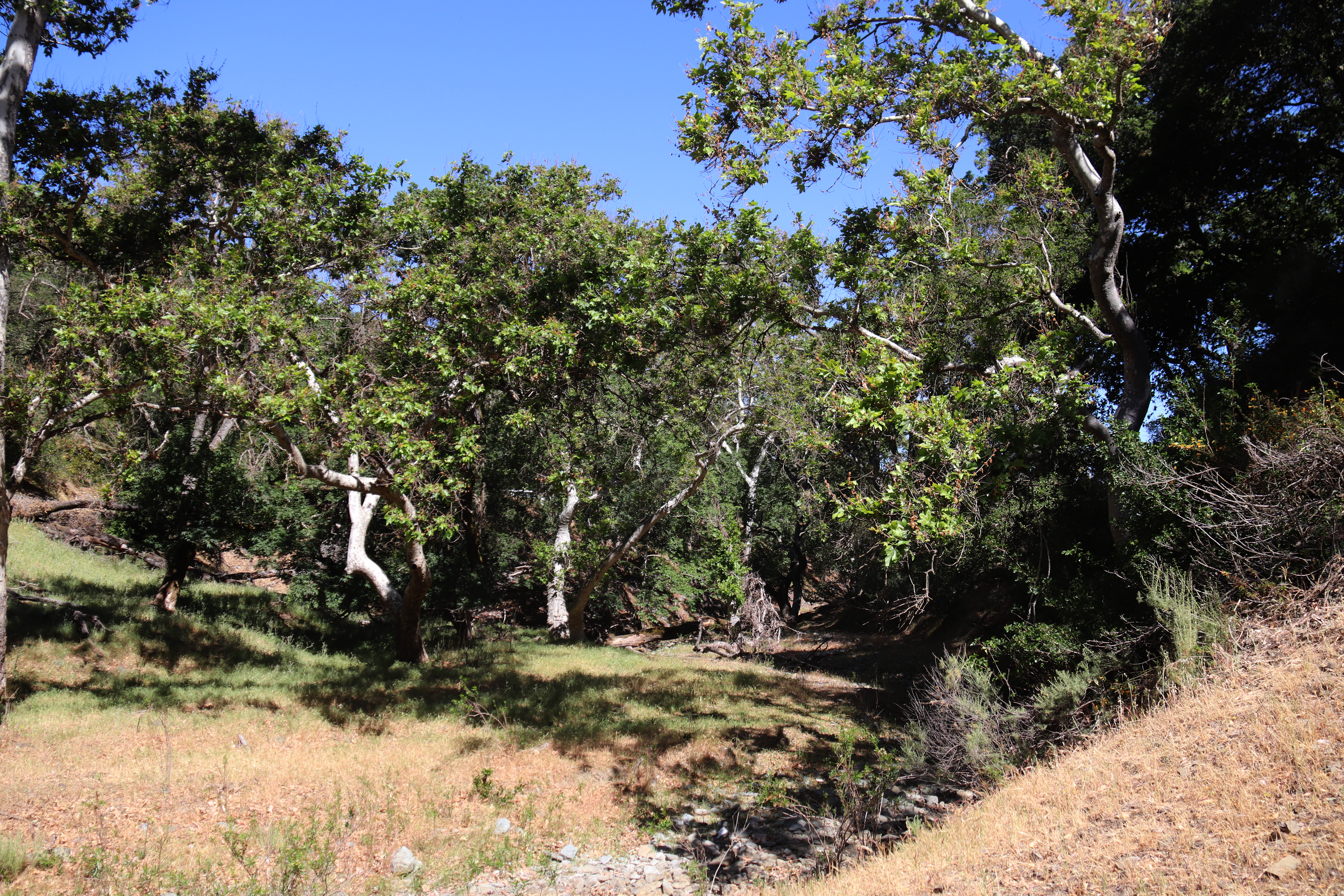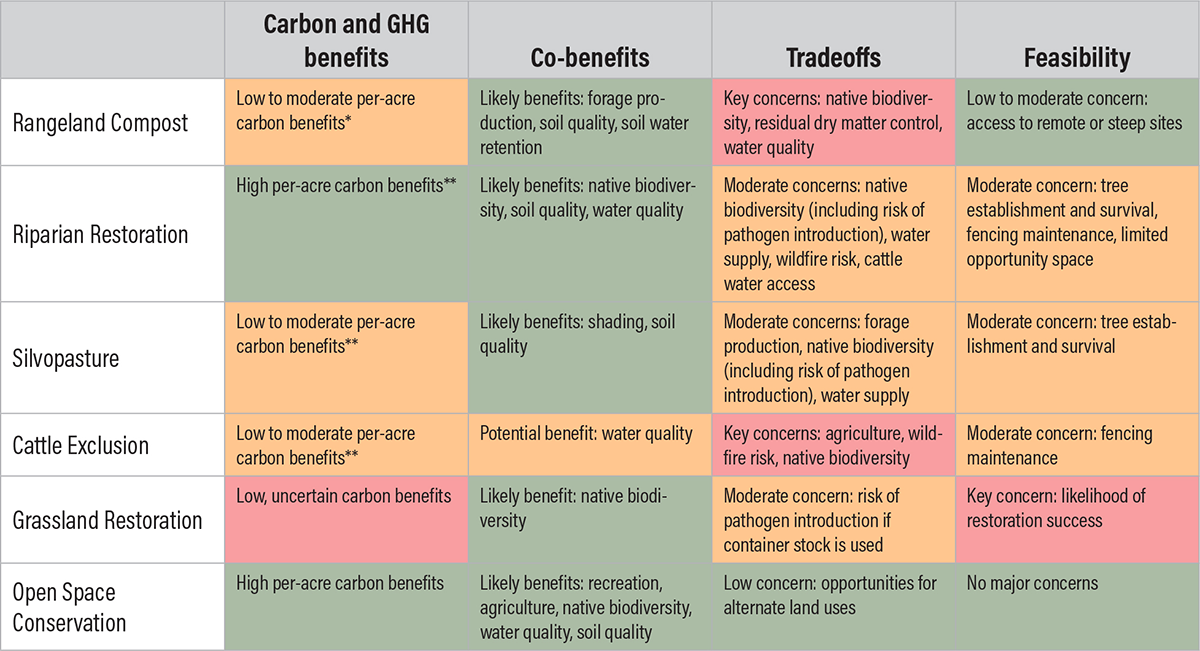Managing Open Space in Support of Net Zero
Protecting carbon stocks and increasing carbon sequestration can support climate change mitigation and maintain healthy, resilient ecosystems. To support SFPUC managers in making informed carbon management decisions, the Alameda Watershed Carbon Assessment offers scientific guidance on the watershed’s current and potential performance as a natural climate solution. This assessment was framed by two main objectives: to quantify current carbon stocks in the Alameda Watershed, and to evaluate opportunities to enhance carbon sequestration in its vegetation and soils.
Dates:
2020 to 2023
Funders:
The San Francisco PUC
Associated Staff:
Programs and Focus Areas:
Resilient Landscapes Program
Carbon, Ecosystems & Climate



Protecting carbon stocks and increasing carbon sequestration can support climate change mitigation and maintain healthy, resilient ecosystems. To support SFPUC managers in making informed carbon management decisions, the Alameda Watershed Carbon Assessment offers scientific guidance on the watershed’s current and potential performance as a natural climate solution. This assessment was framed by two main objectives: to quantify current carbon stocks in the Alameda Watershed, and to evaluate opportunities to enhance carbon sequestration in its vegetation and soils. A central tenet of this analysis is that the value of any management action depends on the ecological context. Ecologically appropriate carbon management activities should provide durable, long-term greenhouse gas benefits, support multiple ecosystem functions, and avoid or minimize ecological tradeoffs. This study’s approach and findings can set an example for other public and private lands where managers are interested in making informed decisions around land-based carbon sequestration.
Download the report.
 California’s natural and working lands provide a broad set of functions for ecosystems and people, such as clean water and food provision, biodiversity conservation, climate regulation, and economic support for individuals and communities. Among these functions, carbon storage and sequestration in soil and vegetation has received increasing attention in the policy and management spheres, offering a natural climate solution that complements the deep cuts that are needed in fossil fuel emissions. To meet net zero greenhouse gas (GHG) emissions targets set by state legislation (AB-1279) and local climate action plans, decision makers and land managers are looking to California’s open space–its forests, grasslands, shrublands, and wetlands–to help reduce GHG emissions and draw down atmospheric carbon dioxide (CO2).
California’s natural and working lands provide a broad set of functions for ecosystems and people, such as clean water and food provision, biodiversity conservation, climate regulation, and economic support for individuals and communities. Among these functions, carbon storage and sequestration in soil and vegetation has received increasing attention in the policy and management spheres, offering a natural climate solution that complements the deep cuts that are needed in fossil fuel emissions. To meet net zero greenhouse gas (GHG) emissions targets set by state legislation (AB-1279) and local climate action plans, decision makers and land managers are looking to California’s open space–its forests, grasslands, shrublands, and wetlands–to help reduce GHG emissions and draw down atmospheric carbon dioxide (CO2).
To support SFPUC managers in making informed carbon management decisions, this carbon assessment for the Alameda Watershed offers scientific guidance on the watershed’s current and potential performance as a natural climate solution. Two main objectives framed this analysis: to quantify existing carbon stocks in the watershed, and to evaluate opportunities to enhance carbon sequestration in the watershed’s vegetation and soil.
Current levels of vegetation and soil carbon storage were estimated watershed-wide using a variety of data sources and models. Six potential carbon management strategies were then evaluated to assess potential carbon benefits and summarize co-benefits, tradeoffs, and other considerations. The analysis approach and management considerations presented in this study are expected to be applicable to many other open space settings around the Bay Area and throughout the central California coast.
Report authors: Lydia Vaughn, Sean Baumgarten, Helen Casendino, Erik Ndayishimiye, Matthew Benjamin, Denise Walker, Clara Kieschnick, David Peterson, Gloria Desanker, Letitia Grenier
Report design: Ruth Askevold, Katie McKnight, Jennifer Symonds , Brandon Herman, Denise Walker
Website: Vanessa Lee, Gemma Shusterman
Funders
San Francisco Public Utilities Commission (SFPUC)
Project Advisors
Patrick Gonzalez (UC Berkeley)
John Battles (UC Berkeley)
Valerie Eviner (UC Davis)
Felix Ratcliff (LD Ford, Consultants in Rangeland Conservation Science)
Margaret Torn (Lawrence Berkeley National Laboratory and UC Berkeley)
Alison Forrestel (National Park Service)
Ronald Amundson (UC Berkeley)
Lauren Hallett (University of Oregon)
Elizabeth Porzig (Point Blue Conservation Science)
Maegen Simmonds (Lawrence Berkeley National Laboratory)
Contact Information
If you have any questions or concerns, please contact Lydia Vaughn.

Encompassing 39,000 acres in the East Bay, the Alameda Watershed is one of the largest public land holdings in the San Francisco Bay Area. The site of several water supply reservoirs, the watershed is managed by the San Francisco Public Utilities Commission (SFPUC) for both water resources protection as well as biodiversity conservation, fire risk reduction, and other goals. The landscape is characteristic of the region, with rugged topography and vegetation dominated by grasslands, shrublands, and oak woodland habitats, along with riparian forests and wetlands (Fig. 1). Carbon sequestration in the watershed’s ecosystems has received increasing attention as a potential nature-based strategy toward San Francisco’s net zero GHG emissions goal.

Figure 1. Distribution of generalized ecosystem types in the watershed.
In total, ecosystems within the Alameda Watershed store an estimated 2.5 million metric tons of carbon (MMT C), including 0.54 MMT C in vegetation and 1.9 MMT C in soil (Table 1). Vegetation carbon includes carbon stored in aboveground and belowground living plant tissues as well as dead plant tissues such as standing and downed wood, leaf litter, and duff, while soil carbon includes carbon stored in soil organic matter.
Soil carbon is by far the biggest carbon pool (~4x greater than vegetation carbon), though the proportion of carbon stored in soil varies from approximately 50% in riparian forest to 97% in grassland (Fig. 2). Vegetation carbon storage, which is more variable than soil carbon, is lowest in grasslands and highest in ecosystems with dense woody vegetation such as riparian forest and oak woodlands; shrublands (coastal scrub and chaparral) and oak savanna have low to moderate levels of vegetation carbon.
While per-acre carbon storage is greatest in riparian forests, these forests only occupy 2% of the watershed area, and thus account for only 3% of total ecosystem carbon storage in the watershed. In contrast, grasslands account for 24% of total ecosystem carbon storage in spite of relatively low per-acre carbon storage, due to their extensive spatial coverage across the watershed.


Figure 3.5. Per-acre carbon storage for ecosystem types in the Alameda Watershed. The size of each semi-circle represents the relative amount of carbon per acre stored in aboveground live and dead vegetation, roots, and soil organic matter for each of the six major ecosystem types.
 Wildfire is common in Mediterranean-type ecosystems. Fires convert carbon stored in vegetation and surface soils into CO2, methane, and other climate pollutants. In the Alameda Watershed, for instance, the 2020 SCU Lightning Complex fires burned 10,370 acres of watershed lands, resulting in an estimated loss of 33,100 MT C (~8% of total vegetation carbon; Fig. 3). This carbon may be recovered in the coming decades through vegetation regrowth, but the pace and overall magnitude of recovery depends on regeneration success, vegetation succession, and potential future fires or other disturbances. California’s 2020 wildfire season highlights the vulnerability of carbon sequestered in fire-prone ecosystems. If climate change increases wildfire frequency and severity, as has been predicted for California, carbon gains due to vegetation growth and regrowth may not be able to keep pace with wildfire-related losses.
Wildfire is common in Mediterranean-type ecosystems. Fires convert carbon stored in vegetation and surface soils into CO2, methane, and other climate pollutants. In the Alameda Watershed, for instance, the 2020 SCU Lightning Complex fires burned 10,370 acres of watershed lands, resulting in an estimated loss of 33,100 MT C (~8% of total vegetation carbon; Fig. 3). This carbon may be recovered in the coming decades through vegetation regrowth, but the pace and overall magnitude of recovery depends on regeneration success, vegetation succession, and potential future fires or other disturbances. California’s 2020 wildfire season highlights the vulnerability of carbon sequestered in fire-prone ecosystems. If climate change increases wildfire frequency and severity, as has been predicted for California, carbon gains due to vegetation growth and regrowth may not be able to keep pace with wildfire-related losses.
Land managers have a range of tools to increase carbon storage on natural and working lands, depending on the landscape setting and vegetation type. These carbon sequestration strategies vary considerably in their feasibility and potential to provide carbon and GHG benefits. For land managers focused on supporting healthy ecosystems, it is critical to assess whether carbon management strategies are aligned with other management goals such as biodiversity conservation and protection of water resources. A thorough consideration of co-benefits and tradeoffs is essential when managing for multiple ecosystem functions.
This study evaluated six potential carbon management strategies in the context of the Alameda Watershed, including compost application on rangelands, riparian forest restoration, silvopasture, cattle exclusion, native grassland restoration, and open space conservation. The following table summarizes the key considerations associated with each strategy, including carbon and GHG benefits, co-benefits, tradeoffs, and feasibility.





